You may recall I did a news story on the 7th of April 2009 concerning Pit-Roads release of a kitset of the USS Perceval, a character from the movie “Last Operations Under the Orion“.
Outlined below and I quote is the subsequent post from John B Agnew aka ussslater which prompted this article:
“Concerning the “fictitious” USS Perceval, in actuality the Japanese producers went to some very accurate realism. The Perceval is actually the USS Slater DE766 which is the only remaining DE afloat. One other ship exists in dry dock in Galveston, condition unkown after the hurricane.
My father was the supply officer on the USS SLATER which is now a museum ship in the Port of Albany NY.
The Slater was used for 2 weeks last August for the film. My family (my father is deceased) continues to go to the reunions and we just got back from Albany yesterday after the 24th annual reunion. 10 remaining crew of the original 216 attended along with approx. 40 family members.
The “World Premiere” so to speak was held at the Palace Theatre in Albany on Friday night, May 29. It was ASWESOME, and the producers, director and the 2 lead Americans were there. A procalamation was read by the mayor from the Governor of NY.
The story is basically “Enemy Below” (Robert Mitchum, Curt Jurgrns) except instead of Germans vs. Americans in the Atlantic, it was Japanesse vs. American in the Pacific.
To see the USS Slater (which was also featured in the movie “The Guns of Navarone” ) was very emotional and prideful.
In fact, my father’s ashes were cast of the bow of the USS SLATER in October 2001, 4 months after his death in a military memorial complete with ? gun salute.
You can read more about the SLATER at
http://www.ussslater.org/
John B. Agnew,
Son of supply officer Lt (jg) John P. Agnew, USS SLATER”
Inspired by this personal insight I undertook some rudimentary research about the USS Slater and this brief article is the by-product of that endeavour.
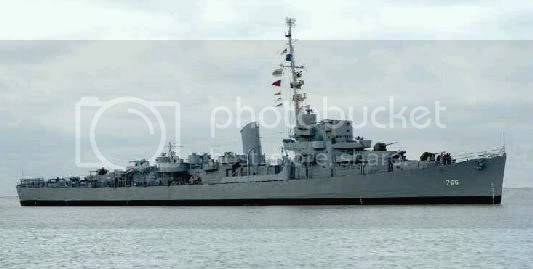
The USS Slater (DE-766) is a Cannon-class destroyer escort that served in the United States Navy and later in the Hellenic (Greek) Navy.
She was named after Frank O. Slater of Alabama, a sailor killed on the USS San Francisco (CA-38) during the Naval Battle of Guadalcanal. He was posthumously awarded the Navy Cross for gallantry in action.
It was a common practice at the time for Destroyer Escorts to be named after Naval heroes, particularly those from early in World War II.
The USS Slater was laid down on the 9th of March, 1943, launched on the 13th of February, 1944, and commissioned on the 1st of May, 1944.
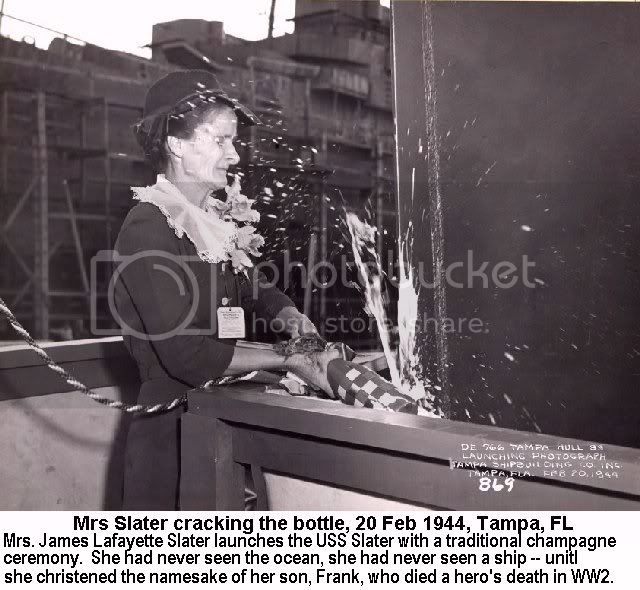
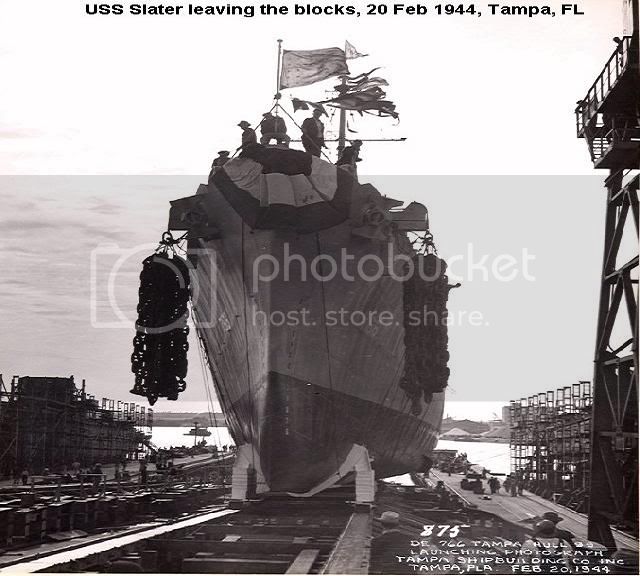
She was built at the Tampa Shipbuilding Company in Tampa, Florida.
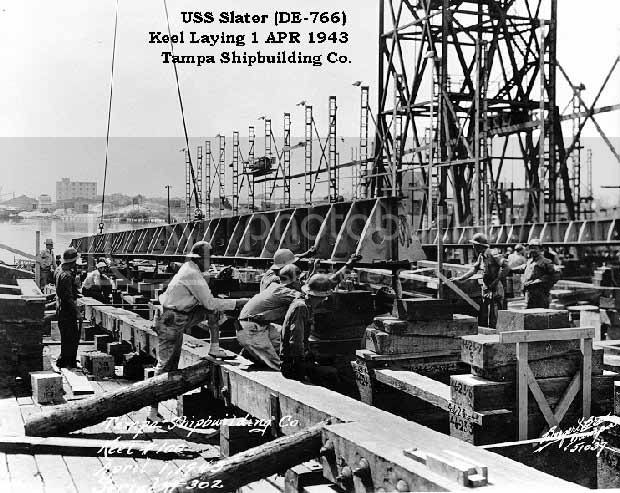
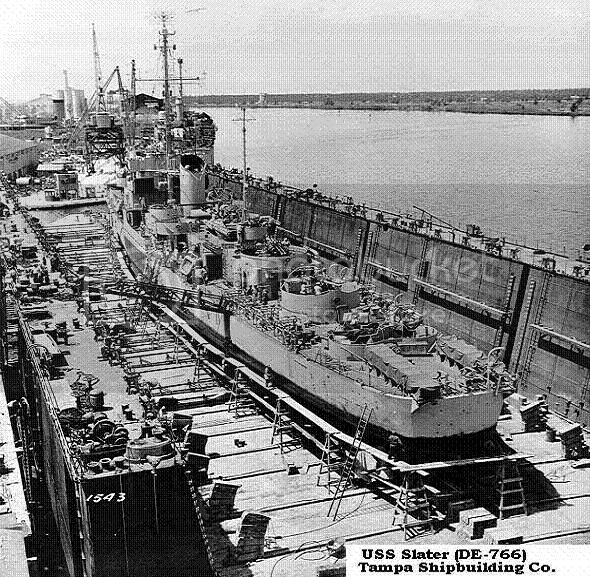
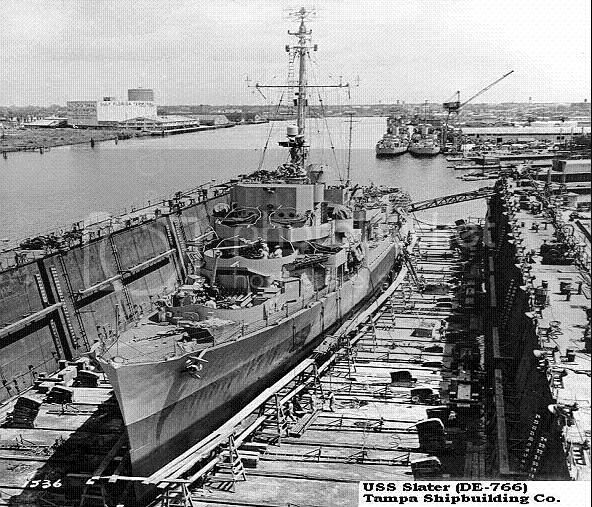
General statistics
Displacement: 1,240 tons
Length: 306 ft (93 m)
Beam: 36 ft 8 in (11.2 m)
Draft: 8 ft 9 in (2.7 m)
Propulsion: 4 GM Mod. 16-278A diesel engines with electric drive
4.5 MW (6,000 shp), 2 screws
Speed: 21 knots (39 km/h)
Range: 10,800 nmi. at 12 knots
Crew Complement: 15 officers, 201 enlisted
Armament: (as built) 3 x 3-in.(76mm)/50 guns (3x1)
2 x 40 mm AA guns (1x2)
10 x 20 mm AA guns (10×1)
3 x 21 in. torpedo tubes (1×3)
8 x depth charge projectors
1 x depth charge projector (hedgehog)
2 x depth charge racks
After a shakedown cruise near Bermuda in June 1944, the USS Slater was sent to Key West where she served as a target ship and later a sonar school ship. In the later part of 1944, the USS Slater escorted two convoys to the United Kingdom. She continued serving in this capacity from January 1945 until May 1945.
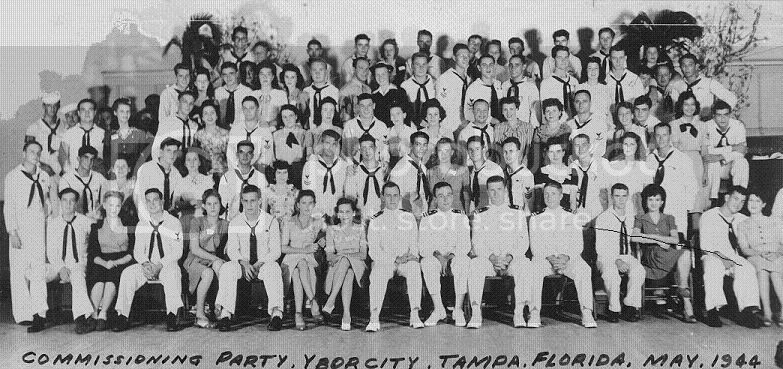
When the war in Europe finally ended, the Slater headed to the Pacific, stopping at Guantanamo Bay and Panama. She went through the Panama Canal on the 28th of June, 1945 and stopped at San Diego before sailing to Pearl Harbour. From there she joined Task Unit 33.2.4 at Manila in September and escorted it to Yokohama. The Slater engaged in support operations in the Pacific through the remainder of the year. She made yet another passage through the Panama Canal on her way to Norfolk for final deactivation. The Slater was placed in the reserve fleet at Green Cove Springs, Florida in 1947.
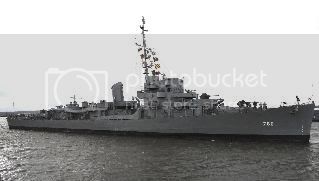
On the 1st of March 1, 1951, the Slater was transferred to the Hellenic (Greek) Navy under the Truman Doctrine, and renamed Aetos "Eagle" (D-01). Along with three other Cannon-class ships, she made up what was known as the "Wild Beasts" Flotilla. The ship did patrol duty in the eastern Aegean and the Dodecanese and also served as a training vessel for naval cadets. The Aetos was decommissioned in 1991, and Greece donated the ship to the Destroyer Escort Sailors Association.
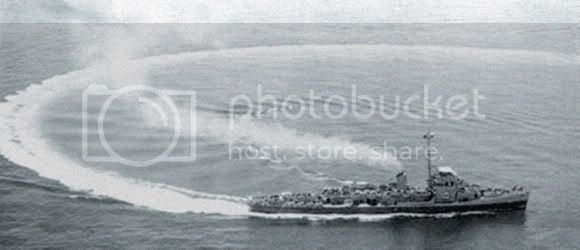
Destroyer escort sailors from around the United States donated $275,000 to bring the Slater back to the United States as a museum ship. A Russian ocean-going tugboat towed the ship from Crete to New York City in 1993, where it was docked next to the USS Intrepid. Volunteers began restoring the ship and seeking a permanent home for her; Albany, New York was finally decided upon.
On Sunday, October 26, 1997, the Slater arrived at the Port of Albany.
In January 2006, a welder accidentally started a fire aboard the Slater which caused some minor damage to the ship. Repairs were completed within a few months. The restoration of the ship remains an on-going project.
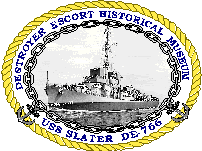
The Destroyer Escort Historical Museum hired historic ship expert Tim Rizzuto, formerly of the USS Kidd in Baton Rouge, to lead Slater's restoration. Assisted by education and tour coordinator, Nancy Buxton, Rizzuto recruited and organized teams of volunteers to complete the ship's restoration. Professionals donate their time to bring about the ship's transformation. For example, the electrical team worked for months in the dark in freezing temperatures with only flashlights to guide them in order to restore electrical power to the ship.
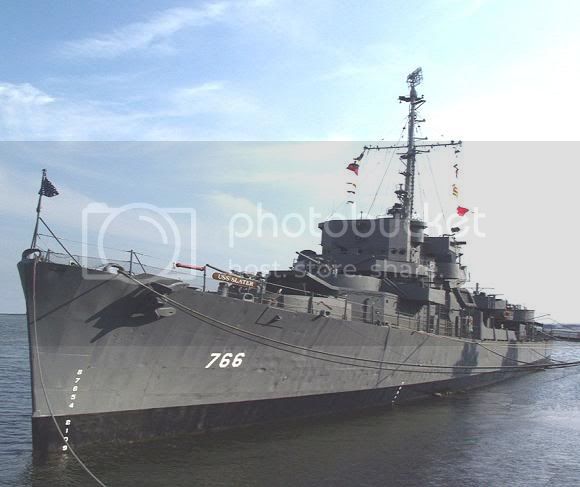
The USS Slater is owned by the Destroyer Escort Historical Museum (DEHM), a 501 (c) 3 organization.
The ship is not owned by the US Navy and therefore is now not subject to recall to active service in the event of war.
On the 7th of May, 1998, the Slater was listed on the National Register of Historic Places.
The Slater was refitted several times during her long service with two navies. All of her torpedo tubes, one of her depth-charge racks, and four "K-gun" depth charge launchers had been removed. Now two twin Bofors 40mm guns have been added, and the ten single 20mm guns have been replaced with nine twin mounts.
The USS Slater is now a museum ship on the Hudson River in Albany, New York, the only one of its kind afloat in the United States. (As I understand it the USS Stewart (DE-238) is exhibited at Seawolf Park in Galveston, Texas, but is located on dry land.)
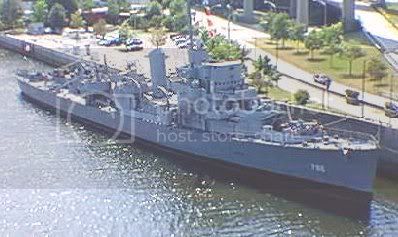
The Slater is open to the public from April through November. Tours are given on Wednesday through Sunday from 10:00 AM to 4:00 PM. Admission is $7.00 for adults, $6.00 for senior citizens, and $5.00 for children aged six to fourteen (those under six are free).
Tour guides many of them Navy veterans, lead visitors through the ship to help them gain a sense of how the 216-man crew operated.
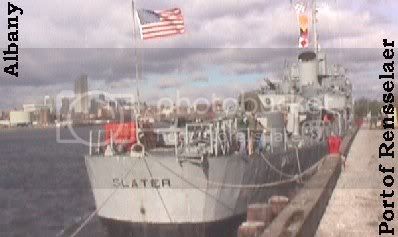
The Slater has also been featured in two movies. The first was when the ship was seen in The Guns of Navarone (1961) whilst in Greek navy service. The second was more recently - in August 2008 as part of the Japanese film "Last Operations Under the Orion" now released was filmed on board.
It is great to finish an article where you are not outlining how a fine warship is decommissioned and then scrapped.
I know that this ship is on my list of museum “must sees” next time I am Stateside again.
Images courtesy of http://www.ussslater.org/ and Wikipedia.
Footnote
In compiling this article I have made reference to a number of established internet sources.
It is acknowledged that a part or portion of the above information may have been sourced from the following sources and credit is duly acknowledged:
Bibliography – websites
Wikipedia
http://www.ussslater.org/
http://www.hnsa.org
http://www.ibiblio.org
http://www.geocities.com/Pentagon/6260/









